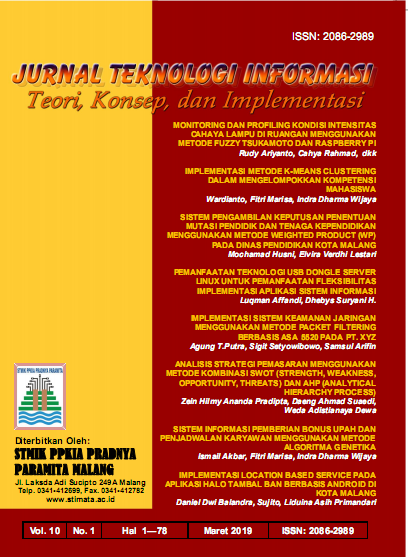MONITORING DAN PROFILING KONDISI INTENSITAS CAHAYA LAMPU DI RUANGAN MENGGUNAKAN METODE FUZZY TSUKAMOTO DAN RASPBERRY PI
Abstract
Increasing the use of electricity resources can lead to an energy crisis, so efforts are needed to make efficient use of these resources. Malang State Polytechnic is one of the educational institutions that needs electrical energy to support learning activities. Based on the total number of students more than 10,000 so that the electrical power used daily can be categorized as very large. Along with the development of information technology that is increasingly rapid, it is possible to build an application to monitor the use of electricity resources so that it is expected to minimize the use of electrical energy that is not so important. This study using the Fuzzy Tsukamoto and Raspberry PI methods for monitoring and profilling light conditions. Input variables used are light and time which consists of five linguistic values. This research was implemented in 2 laboratory rooms at Malang State Polytechnic. The Raspberry Pi can monitor the light intensity in a room using two inputs, namely light and time, then the inoutan will be processed using fuzzy inference to get a very low, low, medium, high, and very high output score. So that the light intensity intensity monitoring system in this study can be used to conduct the conditions of the use of electrical energy, especially the power of indoor lighting.
Keywords : Fuzzy Tsukamoto, Light, Monitoring, Profilling, Raspberry Pi
References
Albreem, M. A. M., El-saleh, A. A., Isa, M., Salah, W., Jusoh, M., Azizan, M. M., & Ali, A. (2017). Green Internet of Things ( IoT ): An Overview. IEEE International Conference on Smart Instrumentation, Measurement and Applications (ICSIMA), (November), 28–30.
Balamurugan, C. R. (2017). Development of Raspberry pi and IoT Based Monitoring and Controlling Devices for Agriculture Development of Raspberry pi and IoT. Journal of Social, Technological and Environmental Science •v.6, 6(August), 207–215. https://doi.org/10.21664/2238-8869.2017v6i2.p207-215
Jin, Y. (2003). Advanced Fuzzy Systems Design and Applications. [e-book] SAGE Publication. Tersedia di: <https://books.google.co.id/books> [Diakses 10 Juli 2018]
Joshi, M., & Gohel, C. (2013). Agent Base Network Traffic Monitoring. International Journal of Innovative Research in Science, Engineering and Technology, 2(5), 1799–1803.
Shah, K., Gajjar, D., & Patel, M. S. (2015). Embedded System Design Using. International Journal of Electrical and Electronics Research, 3(1), 74–75.
Zhao, C. W., Jegatheesan, J., & Loon, S. C. (2015). Exploring IOT Application Using Raspberry Pi. International Journal of Computer Networks and Applications, 2(1), 27–34.




